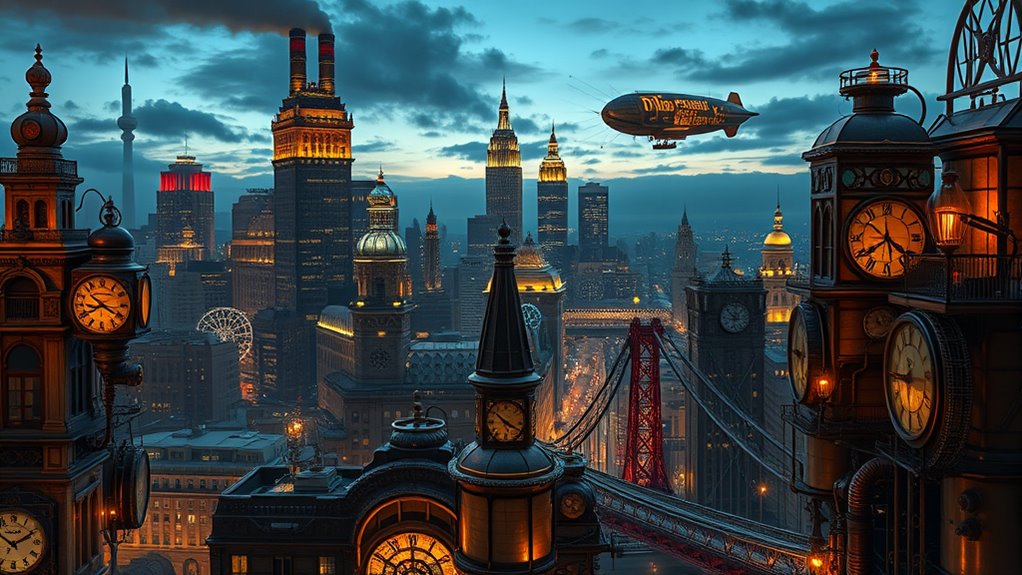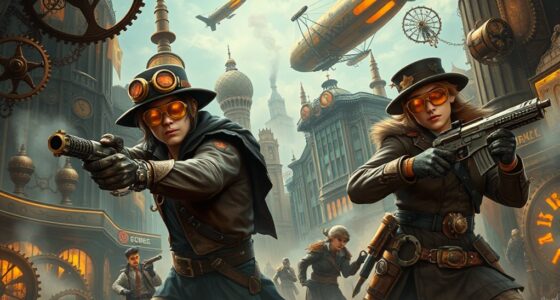Steampunk blends both science fiction and fantasy by creating a Victorian-inspired world where steam-powered machines and inventive contraptions operate within a rich, nostalgic aesthetic. It explores scientific plausibility while imagining fantastical inventions and alternate histories, making it feel rooted yet magical. Whether you see it as a type of science fiction or fantasy depends on how much emphasis you place on the scientific elements versus the imaginative. Keep exploring to discover how these worlds come to life.
Key Takeaways
- Steampunk blends Victorian-era aesthetics with technological innovations rooted in steam power and clockwork, creating a visually rich universe.
- It features both fantastical inventions and plausible scientific principles, merging fantasy and scientific plausibility.
- Stories often involve inventors and explorers, exploring alternate histories and magical-like machinery.
- Its hybrid nature allows it to be viewed as either a science fiction universe or a fantasy realm.
- Overall, steampunk is a genre that combines elements of both science fiction and fantasy, making it a unique cross-genre style.

Is steampunk more of a fantasy domain or a science fiction universe? That’s a question many enthusiasts find intriguing, because steampunk uniquely blurs the lines between the two. At its core, steampunk offers an aesthetic appeal rooted in Victorian-era design, with intricate gears, brass fittings, and vintage machinery that evoke a sense of nostalgic wonder. This visual style draws you in, creating a world that feels both familiar and fantastical. But beyond its captivating look, steampunk also explores technological plausibility, imagining innovations driven by steam power and clockwork mechanisms. It invites you to consider what could have been if history had followed a different technological trajectory, blending real scientific principles with imaginative possibilities. This combination makes steampunk a fascinating hybrid where fantasy and science fiction coexist.
Steampunk blends Victorian aesthetics with plausible steam-powered inventions, creating a captivating hybrid of fantasy and science fiction.
You might see steampunk as more of a fantasy realm because of its emphasis on fantastical inventions, alternate histories, and worlds where magic-like machines operate seamlessly within Victorian settings. Its stories often feature inventors and explorers *setting out* on adventures that push the boundaries of reality, creating a universe where the impossible becomes tangible. The aesthetic appeal plays a big role here, immersing you in a richly detailed universe that feels like an elaborate costume party from the 19th century, yet with elements that seem to defy the limits of real science. The allure lies in the extraordinary, the whimsical, and the imaginative, making it feel more like a fantasy universe where anything can happen.
However, steampunk also leans toward science fiction because of its focus on technological plausibility. Despite the fantastical appearance, its inventions are often grounded in real scientific principles like steam engines, gears, and clockwork mechanisms. You can see the effort to make these devices plausible within the universe’s framework, even if they’re exaggerated or creatively reimagined. Steampunk’s appeal partly comes from imagining what might have been possible with the scientific knowledge of the Victorian era, combined with a creative twist. It’s like a thought experiment that pushes the boundaries of what technology could achieve, giving it a solid foundation in scientific plausibility while still allowing room for imaginative embellishments.
In the end, steampunk exists comfortably in a space where fantasy and science fiction meet. Its aesthetic appeal enchants you visually, while its focus on plausible technology invites curiosity about scientific possibilities. Whether you see it as a fantasy universe or a science fiction one, what matters most is how it sparks your imagination and transports you to a world that’s both beautifully crafted and intellectually engaging.
Frequently Asked Questions
How Does Steampunk Differ From Cyberpunk?
You’ll find that steampunk differs from cyberpunk mainly in aesthetic origins and design influences. Steampunk draws from Victorian-era aesthetics, with intricate gearwork, brass, and steam-powered technology, reflecting a historical, nostalgic vibe. Cyberpunk, on the other hand, emphasizes a futuristic, high-tech look rooted in digital innovation, neon lights, and cybernetics. While both explore alternative worlds, steampunk’s charm lies in its vintage-inspired design, whereas cyberpunk’s style is sleek and dystopian.
Are Steampunk Stories Set in Alternative Histories?
You’re right—steampunk stories often unfold in alternative histories, where a technological divergence changes everything. Imagine a world where steam-powered machines dominate, and history took a different turn. As you explore these settings, you’re drawn into a rich tapestry of innovation and intrigue, blending Victorian aesthetics with futuristic ideas. This alternate timeline keeps you guessing, revealing a universe shaped by different choices, yet familiar enough to captivate your imagination.
Can Steampunk Include Elements of Magic?
Yes, steampunk can include elements of fantasy magic. You might encounter stories where mystical technology blends seamlessly with Victorian-inspired settings, creating a unique mix of fantasy magic and steampunk innovation. This fusion allows for imaginative worlds where magical powers coexist with steam-powered machinery, enriching the narrative. So, if you enjoy fantastical elements alongside technological wonders, steampunk offers a versatile genre that embraces both mystical technology and fantasy magic.
Is Steampunk More Popular in Books or Movies?
You might think movies showcase steampunk more, but books actually hold the crown. Ironically, while movies flaunt dazzling visuals of steam-powered gadgets and Victorian aesthetics, it’s in literature where the genre truly flourishes, immersing you in detailed worlds. Films often skim the surface, but books let you explore the intricate, steam-filled universe. So, if you love rich descriptions and imaginative settings, you’ll find steampunk more vibrant in books.
What Are Common Steampunk Technological Themes?
You’ll find that steampunk’s common technological themes blend Victorian innovations with aesthetic influences like gears, steam engines, and clockwork machinery. You’re drawn to the retro-futuristic vibe, where brass gadgets and mechanical contraptions showcase a fascination with Victorian-era engineering. This fusion creates a unique world where advanced technology coexists with vintage style, emphasizing craftsmanship, exploration, and inventive spirit rooted in Victorian aesthetic influences and innovations.
Conclusion
So, when you explore steampunk, you realize it’s a blend that blurs lines between fantasy and science fiction. Imagine walking through a city where airships drift above steam-powered machines—it’s both magical and technological. Just like in the case of “The League of Extraordinary Gentlemen,” where Victorian-era inventions meet fantastical adventures, steampunk invites you to imagine worlds where science and fantasy seamlessly intertwine. Ultimately, it’s up to you to decide which side it leans toward more.









